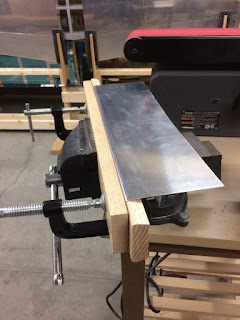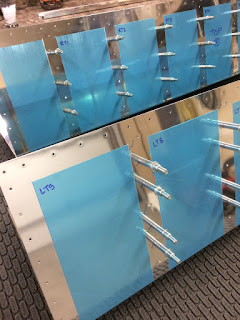
I was sure to cut it to fit 0.025" material on each end of the blocks.

I then radius'd all the corners 1/8" and began to complete all my bends on the cross piece. Lots of triming, filing and sanding. Here is the near complete brace.

Now that I had the template I then set up to place the rivet line centered in the brace but staggered in the middle of the wing rib rivets.


I was now ready to clamp the assembly together and check fitment.

One of the items that I wanted to make is a proper aluminum template for the pitot mast to locate the hole in the skin. The paper template that comes with the mast is very poor. So I used some thin 0.016" thick aluminum and went to work. Best way I found was to cut the holes with a unibit, and then take down large chucks with a round file, then finish with the dremel sanding drums.

Next I cleco'd the newly fabricated mast template to the wing assembly with the mast installed and everything cleco'd in place. I could then transfer the rivet holes for the cross bracket into the mast template.
Next step I removed the mast, and then celco'd the wing skin on to match drill the cross bracket holes in the wing skin.

I fitted the skin to the wing and very carefully drilled the rivet holes in the skin for the cross bracket.
Once the skin was removed, I could then cleco on the mast template directly onto the skin with precision alignment.

I marked the leading edge of the template and cut it inline with the leading edge of the skin. I cut the top of the mast template as well as it was excessive. I also drilled the two holes that attach the aft end of the mast to the skin.

Next I celco'd the assembly together to finish the rest of the match drilling and to drill in the nutplates that secure the cross bracket to the pitot mast angle bracket.

Little bit of final trimming to do to clear the welds on the mast.

All done. It was a long day but very productive and very precise. Many of the steps where a bit excessive, but at the end of the day I am really pleased with how well it turned out.








































